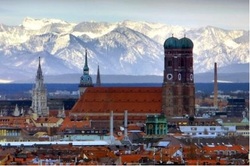
Introduction
Munich is the capital of
Bavaria. 1, 2 Million inhabitants live there It’s a very big and exciting city.
There are many sights for example the: “Marienplatz”. For teenagers Munich is a
wonderful place. We like to go there.
Munich is about 100 km away from us. Munich has the motto “München mag dich” (Munich likes you).
We are going to tell you about the:
+history of Munich
+ sights
+ And the footblall-club "FC Bayern-München"
From: Ali (Alicia) ,Lisa H. ,Sarah S. ,Babsee (Barbara)
Munich is the capital of
Bavaria. 1, 2 Million inhabitants live there It’s a very big and exciting city.
There are many sights for example the: “Marienplatz”. For teenagers Munich is a
wonderful place. We like to go there.
Munich is about 100 km away from us. Munich has the motto “München mag dich” (Munich likes you).
We are going to tell you about the:
+history of Munich
+ sights
+ And the footblall-club "FC Bayern-München"
From: Ali (Alicia) ,Lisa H. ,Sarah S. ,Babsee (Barbara)
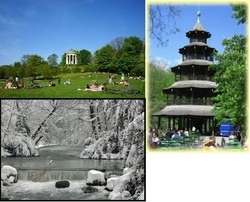
English Garden
History
The English Garden was created in the late 1700s. originally it was
supposed to be a so-called "military garden", designed to provide soldiers with
information on agriculture and also give them a place to enjoy outdoor
recreation. The military gardens opened in 1789 and soon thereafter, Carl
Theodor established Munich's first public park to the east of the gardens. It
opened in 1792. Eventually, the land that included the military gardens was
added to the public park.
What to See
The words English Garden refer to the style of landscaping throughout
the park;. The park is larger than New York's Central Park However, visitors do indeed flock to the two Beer Gardens located in
each section of the park. In summer a lot of people go sunbathing there, often
in the nude, play games or watch the surfers on the little
‘Eisbach’river.
Chinesischer Turm
A popular meeting point is the Chinesischer Turm is a 25-meter-high
structure. The tower, built at the end of the 18th century, was bombed during
World War II and rebuilt to its original design. It is Munich´s second largest
beer Garden.
History
The English Garden was created in the late 1700s. originally it was
supposed to be a so-called "military garden", designed to provide soldiers with
information on agriculture and also give them a place to enjoy outdoor
recreation. The military gardens opened in 1789 and soon thereafter, Carl
Theodor established Munich's first public park to the east of the gardens. It
opened in 1792. Eventually, the land that included the military gardens was
added to the public park.
What to See
The words English Garden refer to the style of landscaping throughout
the park;. The park is larger than New York's Central Park However, visitors do indeed flock to the two Beer Gardens located in
each section of the park. In summer a lot of people go sunbathing there, often
in the nude, play games or watch the surfers on the little
‘Eisbach’river.
Chinesischer Turm
A popular meeting point is the Chinesischer Turm is a 25-meter-high
structure. The tower, built at the end of the 18th century, was bombed during
World War II and rebuilt to its original design. It is Munich´s second largest
beer Garden.
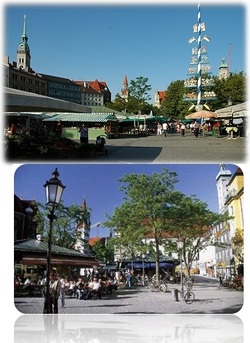
The Victuals Market
The Victuals
Market, only a few steps from the Marienplatz, is Munich's most popular open air
market. A walk across the "Victuals Market" can be a sensual revelation. Stalls
not only offer the freshest fruits and vegetables in Munich, but traditional
Bavarian Schweinshax'n (a pork roast) and Bacon , sea food, delicious cheeses
from all over Europe, herbs, honey products, sushi and hand-made straw puppets
are also for sale. Or would you prefer a freshly squeezed apple-carrot-ginger
juice? For all those who appreciate culinary seduction of the senses, this is
the perfect place to spend your lunch break, get inspired for new creations, and
buy those rare and special herbs and spices that can't be found anywhere else in
the region.However, although this is its main purpose, the Victuals Market is
not only a place for buying and selling : the market also hosts a number of
traditional and folkloric events, such as the colorful carnival festivities and
the masked dance of the market women on Shrove Tuesday. Right next to the
Victuals Market is the site of the "Schrannenhalle", built under King Maximilian
I according to a French model. This was a market hall over 430 m long, where
grains were sold, and which burned down in 1932. Rebuilt with the original
wrought-iron frames, the new "Schrannenhalle" was inaugurated in September 2005.
Housing a market, shops, restaurants and cultural venues, the hall is a meeting
place for old and young in the heart of the city.
.
The Victuals
Market, only a few steps from the Marienplatz, is Munich's most popular open air
market. A walk across the "Victuals Market" can be a sensual revelation. Stalls
not only offer the freshest fruits and vegetables in Munich, but traditional
Bavarian Schweinshax'n (a pork roast) and Bacon , sea food, delicious cheeses
from all over Europe, herbs, honey products, sushi and hand-made straw puppets
are also for sale. Or would you prefer a freshly squeezed apple-carrot-ginger
juice? For all those who appreciate culinary seduction of the senses, this is
the perfect place to spend your lunch break, get inspired for new creations, and
buy those rare and special herbs and spices that can't be found anywhere else in
the region.However, although this is its main purpose, the Victuals Market is
not only a place for buying and selling : the market also hosts a number of
traditional and folkloric events, such as the colorful carnival festivities and
the masked dance of the market women on Shrove Tuesday. Right next to the
Victuals Market is the site of the "Schrannenhalle", built under King Maximilian
I according to a French model. This was a market hall over 430 m long, where
grains were sold, and which burned down in 1932. Rebuilt with the original
wrought-iron frames, the new "Schrannenhalle" was inaugurated in September 2005.
Housing a market, shops, restaurants and cultural venues, the hall is a meeting
place for old and young in the heart of the city.
.
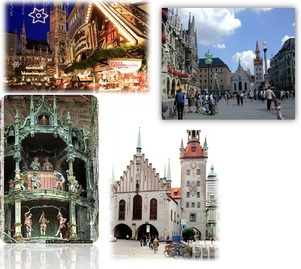
Marienplatz
The Marienplatz is the centre of Munich. There are two townhalls: the old townhall and the new one. The Marienplatz exists since 1158 it was founded by Heinrich der Löwe. In the year 1315 it became the market freedom of Ludwig der Bayer.
Today in winter there is always a christkindlmarkt. There are always lots of stalls and a very big Crhristmastree. And of course there are thousands of lights.
The new one was built in the year 1867 until 1909 there is also the famous chime. Every day at11 o´clock there is the dance of the coopers (the little figures you can see in the picture)
The old one was built in the year 1310.
The Marienplatz is the centre of Munich. There are two townhalls: the old townhall and the new one. The Marienplatz exists since 1158 it was founded by Heinrich der Löwe. In the year 1315 it became the market freedom of Ludwig der Bayer.
Today in winter there is always a christkindlmarkt. There are always lots of stalls and a very big Crhristmastree. And of course there are thousands of lights.
The new one was built in the year 1867 until 1909 there is also the famous chime. Every day at11 o´clock there is the dance of the coopers (the little figures you can see in the picture)
The old one was built in the year 1310.
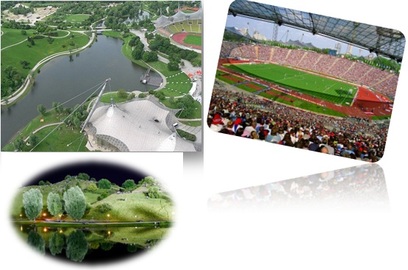
Olympiastadion mit Park
The Olympic stadium was built in 1966, because the Olympic games of the year 1972 were held in Munich. There was also a parc next to the stadium there is a lake and some paved paths and lawn .
There is also the television tower with a restaurant that reside on the top. The Olympic stadium has got an undersoil heating it cost 137 Mio DM and it has around 69.000 seats. The roof of the stadium is a sky dome.
Today there are pop concerts, track meetings and in summer there is the “Tollwutfestival”
The Olympic stadium was built in 1966, because the Olympic games of the year 1972 were held in Munich. There was also a parc next to the stadium there is a lake and some paved paths and lawn .
There is also the television tower with a restaurant that reside on the top. The Olympic stadium has got an undersoil heating it cost 137 Mio DM and it has around 69.000 seats. The roof of the stadium is a sky dome.
Today there are pop concerts, track meetings and in summer there is the “Tollwutfestival”
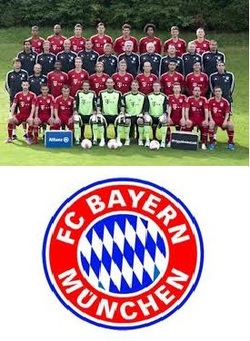
FC Bayern-München
FC Bayern München is a football club from Munich.
FC Bayern München are the giants and they are on the frist from the Bundesliga table. So Bayern-München is the most succesful German football club.
Here is a little profile:
name: Fußball_Club Bayern, München e.V.
place: Munich, Bavaria
founded: 27. February 1900
club colour: red-white
stadium: Allianz Arena
places: 71,137
president: Uli Hoeneß
trainer: Jupp Heynckes
FC Bayern München is a football club from Munich.
FC Bayern München are the giants and they are on the frist from the Bundesliga table. So Bayern-München is the most succesful German football club.
Here is a little profile:
name: Fußball_Club Bayern, München e.V.
place: Munich, Bavaria
founded: 27. February 1900
club colour: red-white
stadium: Allianz Arena
places: 71,137
president: Uli Hoeneß
trainer: Jupp Heynckes
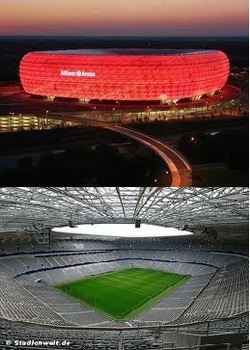
The Allianz Arena
General information about the Allianz
Arena:
The Allianz Arena, opened in 2005 and is home to both major Munich
clubs, Bayern München and TSV 1860, It was designed purley as a football stadium. The architecturally unique arena was constructed viteni not even three years.
General information about the Allianz
Arena:
The Allianz Arena, opened in 2005 and is home to both major Munich
clubs, Bayern München and TSV 1860, It was designed purley as a football stadium. The architecturally unique arena was constructed viteni not even three years.
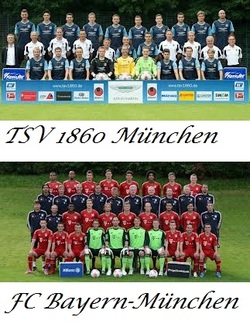
Construction dates:
Foundation stone laid on 21. October 2002 Handover from Alpine Bau
GmbH completed on 30. April 2005.
Opening games:
30. May 2005: TSV 1860 3-2 FC Nuremberg
31. May 2005: FC Bayern 4-2 Germany
Construction cost:
€ 340 million
Parking:
9,800 parking places in four x four-storey Esplanade car parks (the largest Europe)
Inside of the Arena:
-28 Kiosks
-2 fan-restaurants, each with 1,000 seats
- Offices and conference rooms
- 54 ticket counters
- Shopping faclilities
- 2 warm-up rooms
- 550 WC-cubs
Foundation stone laid on 21. October 2002 Handover from Alpine Bau
GmbH completed on 30. April 2005.
Opening games:
30. May 2005: TSV 1860 3-2 FC Nuremberg
31. May 2005: FC Bayern 4-2 Germany
Construction cost:
€ 340 million
Parking:
9,800 parking places in four x four-storey Esplanade car parks (the largest Europe)
Inside of the Arena:
-28 Kiosks
-2 fan-restaurants, each with 1,000 seats
- Offices and conference rooms
- 54 ticket counters
- Shopping faclilities
- 2 warm-up rooms
- 550 WC-cubs
History of Munich (Origin)
The year 1158 is assumed to be the foundation date of Munich,
which is only the earliest date the city is mentioned in a document.
By that time the Guelph Henry the Lion, Duke of Saxony and Bavaria,
built a bridge over the river Isar next to a settlement of Benedictine
monks.The monks' presence dates back to the 8th century, although
settlement in the Munich area can be traced back to the late
neolithic.
To force traders to use his bridge (and charge them for doing so) Henry
also destroyed a nearby bridge owned by bishop Otto von Freising (Freising).
Subsequently the bishop and Henry quarreled about the city before
Emperor Frederick I Barbarossa at an Imperial Diet held in Augsburg in 1158.
This sanctioned Henry's spoliation, and awarded an annual compensation
for the bishop, and also confirmed Munich's trading and currency rights.
Capital of the reunited duchy Bavaria
When Bavaria was reunited in 1506 Munich became the capital of all of Bavaria.
The arts and politics became increasingly influenced by the court.
During the 16th century Munich was a center of the German counter reformation,
and also of renaissance arts. Duke Wilhelm V commissioned the Jesuit Michaelskirche,
which became a center for the counter-reformation, and also built the Hofbräuhaus for
brewing brown beer in 1589.
The Catholic League was founded in Munich in 1609. In 1623 during the Thirty Years' War
Munich became electoral residence when Maximilian I, Duke of Bavaria was invested with the
electoral dignity but in 1632 the city was occupied by Gustav II Adolph of Sweden. When
the bubonic plague broke out in 1634 and 1635 about one third of the population
died.The baroque Theatinerkirche on Odeonsplatz in the historic city centre.
After the war Munich quickly became a center of baroque life. Elector Ferdinand Maria’s
consort Henriette Adelaide of Savoy invited numerous Italian architects and artists to the city,
and built the Theatinerkirche and Nymphenburg palace on the occasion of the birth of their son
and heir Maximilian II Emanuel, elector of Bavaria.Munich was under the control of the Habsburg
family for some years after Maximilian II Emanuel had made a pact with France in
1705 during the War of the Spanish Succession. The occupation led to bloody
uprisings against the Austrian imperial troops followed by a massacre while
farmers were rioting (the "Sendlinger Mordweihnacht" or Murder Christmas of
Sendling). The coronation of Max Emanuel's son elector Charles Albert as Emperor
Karl VII in 1742 led to another Habsburg occupation. The city's first academic
institution, the Bavarian Academy of Sciences, was founded in 1759 by Maximilian
III Joseph, who abandoned his forefather's imperial ambitions and made peace.
From 1789 onwards, when the old medieval fortification was demolished, the
English Garden was laid out - it is one of the world's largest urban public
parks. By that time, the city was growing very quickly and was one of the
largest cities in continental Europe.

 RSS Feed
RSS Feed